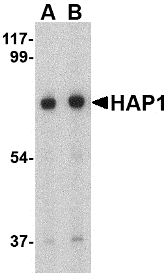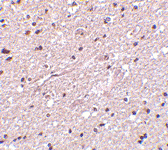Catalog# :4205
Huntington's disease (HD), a neurodegenerative disorder characterized by loss of striatal neurons, is caused by an expansion of a polyglutamine tract in the HD protein huntingtin. HAP1 was initially identified through a two-hybrid library screening; the binding of HAP1 to huntingtin correlated with the expansion of the polyglutamine tract. HAP1 also interacts with two cytoskeletal proteins (dynactin and pericentriolar autoantigen protein 1), suggesting that HAP1 may play a role in vesicular trafficking or organelle transport. HAP1 is also involved with the huntingtin-enhanced BDNF transport along the cellular microtubles. Attenuation of this process led to the loss of neurotrophic support and neuronal toxicity, which suggests that loss of this function might contribute to pathogenesis. Several alternatively spliced isoforms have been described for HAP1.
Additional Names : HAP1, Huntingtin-associated protein 1, neuroan 1, HLP, HIP5

Description
Left: Western blot analysis of HAP1 in mouse brain tissue lysate with HAP1 antibody at (A) 0.5 and (B) 1 µg/ml.
Below:Immunohistochemistry of HAP1 in human brain tissue with HAP1 antibody at 2.5 µg/ml.
Other Product Images
 Source :HAP1 antibody was raised against a 19 amino acid peptide from near the center of human HAP1.
Source :HAP1 antibody was raised against a 19 amino acid peptide from near the center of human HAP1.Purification : Affinity chromatography purified via peptide column
Clonality and Clone : This is a polyclonal antibody.
Host : HAP1 antibody was raised in rabbit.
Please use anti-rabbit secondary antibodies.
Application : HAP1 antibody can be used for detection of HAP1 by Western blot at 0.5 – 1 µg/ml.
Tested Application(s) : E, WB, IHC
Buffer : Antibody is supplied in PBS containing 0.02% sodium azide.
Blocking Peptide :Cat.No. 4205P - HAP1 Peptide
Long-Term Storage : HAP1 antibody can be stored at 4ºC, stable for one year. As with all antibodies care should be taken to avoid repeated freeze thaw cycles. Antibodies should not be exposed to prolonged high temperatures.
Positive Control :
1. Cat. No. 1403 - Mouse Brain Tissue Lysate
2. Cat. No. 1303 - Human Brain Tissue Lysate
Species Reactivity : H, M, R
GI Number : 10241694
Accession Number : CAC09418
Short Description : Huntingtin associated protein 1
References
1. Borrell-Pagès M, Zala D, Humbert S, et al. Huntington's disease: from huntingtin function and dysfunction to therapeutic strategies. Cell Mol. Life Sci. 2006; 63:2642-60.
2. Li X-J, L S-H, Sharp AH, et al. A huntingtin-associated protein enriched in brain with implications for pathology. Nature 1995; 378:398-402.
3. Engelender S, Sharp AH, Colomer V, et al. Huntingtin-associated protein 1 (HAP1) interacts with the p150(Glued) subunit of dynactin. Hum. Molec. Genet. 1997; 6:2205-12.
4. Gauthier LR, Charrin BC, Borrell-Pages M, et al. Huntingtin controls neurotrophic support and survival of neurons by enhancing BDNF vesicular transport along microtubules. Cell 2004; 118:127-38.

No comments:
Post a Comment